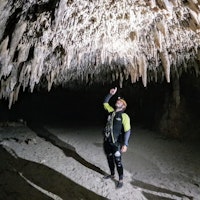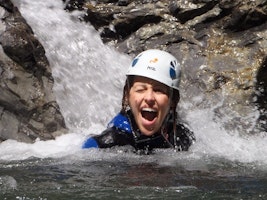Canyoning (or canyoneering) is traversing a canyon or gorge by combining hiking, climbing, swimming, and/or abseiling. A sport by many names, it explores the hard-to-reach areas of a natural landscape by following a water route carved through rock formations.
In navigating paths along streams, pools, and waterfalls, a canyoneer will slide, jump, and descend down through the gorge, often using technical equipment for safety. It can be done primarily for fun and to gain experience, but also for the difficulty of the course and challenges of the terrain.

There are many levels to canyoning, and it can be enjoyed by all ages. The amount of water and the number of vertical obstacles are factors in determining a canyon´s difficulty. Some of the harder and more technical stages of a canyon, like rappels and jumps, can be modified or avoided altogether to make a specific route more accommodating.
The rush of jumping and diving into beautiful pools of water is incredible, and it doesn't require a lot of advanced skills. Abseiling, or rappelling, involves descending into more difficult areas with the significant use of technical equipment, and is considered advanced canyoning.
When is the Best Time of Year to Go Canyoning?
Canyoning is most often enjoyed in comfortable weather, so it is best to head to the gorge in the summer and the months that bookend it. You will be staying active in a wet environment, so warm temperatures and moderate water levels provide the ideal conditions for the sport.
The water level generally relies on winter precipitation and thaw, as well as heavy rains and storms. This should always be considered when making plans for a canyon adventure.

From May to September, you are most likely to find the best times for canyoning. Towards the beginning of the summer, the water levels tend to be higher, and the temperature can vary. For more experienced canyoneers, this can be a great chance to try the challenging aspects of the terrain.
As summer settles in, the delicate balance between warmth and water reaches its peak, and everyone can appreciate the fun and adventure of the gorge. Once autumn arrives, that perfect sporting atmosphere hits the road and the unpredictable climate returns. This can lead to a more hazardous time in the gorge.
What Equipment Do You Need?

It depends on the program, but general canyoning equipment includes:
Canyoning Shoes: Because of the watery nature of a canyon, you will need comfortable, durable shoes with excellent grip.
Wetsuit: Its durability and warmth are essential for cold and deep canyons, and it will keep you dry. Accompanied by a quick-drying shirt and pair of shorts, a wetsuit will prepare you for any wild and woolly adventure.
Helmet: Head protection is a no-brainer. A helmet will safeguard your head through the slips and falls of the canyon.
Gloves: A sturdy pair of gloves can keep your hands safe and sound when cruising the rocks, though they aren't necessarily required. They can also assist in gripping the terrain on your way through the canyon.
Static Rope(s): A static rope holds strong when placed under pressure, and works best for abseiling. These ropes are crucial to your canyoning experience.
In contrast, dynamic ropes are used in – and associated with – climbing for securing falls and enhancing safety during ascents.
Rope Bag: Keep hands focused on the task at hand by carrying ropes in a durable and convenient rope bag. This helps the canyoneer manage them more easily and effectively.
Water-Proof Bag: A water-proof bag or pack will keep your possessions and equipment dry. It should automatically shed and release water as you traverse, and be fairly lightweight to avoid bogging down the descent.
Descender: A belay system is crucial for a safe trip. Used as a friction brake, a descender manages and controls a canyoneer's descent, allowing a belayer to safely give and take rope.
Harness: The harness is a piece of safety gear worn by the canyoneer that attaches to a rope for abseiling and, if necessary, climbing.
Carabiner: For any necessary securing and carrying in the canyon, a carabiner is a tool to connect the harness and the descender. It is a good idea to have a few of these easy-locking devices handy, as they can attach slings and other equipment.
Sling: A sling will hold anchors fast, including the climber, and is a safety precaution helpful as an additional measure in an exposed area.
A small selection of other possible items includes a knife, communication device, sun protection, swimwear, and camera.

Some of this equipment can be rented on-site or prior to a trip, and it may be provided by the canyoning guide. Some programs and circumstances may require participants to provide their own gear. A particular canyon or route may have require additional items based on location or weather.
Why Should You Hire a Guide for Canyoning?
Canyoning is a fun activity, and sharing it with someone else only increases this pleasure exponentially. By hiring a guide, you gain an incredible amount of knowledge and insight. A local guide can even take you on a hidden or more remote route that will give you bragging rights over your friends who took the same old path. The guide can also recommend or alter a program, allowing you to modify certain stages of the route or even avoid the difficult parts to tailor it to your personal abilities and needs.

With the assistance of a professional, you will be able to tackle more obstacles and reach further into the canyon than you might have been able to otherwise. You can A guide enhances your canyoning experience and helps increase your skills at a faster rate. Achieving your goals with precision will make your trip an absolute blast!
Perhaps most importantly, a guide will make your program safe and make sure you still have as much fun as you possibly can.
Top 10 Spots to Go Canyoning in the World:
1. Sierra de Guara, Aragon(Spain): The gorges of this mountainous region are breathtaking, justifying its claim as one of Europe´s top destinations for canyoning. It is has long and wild descents, as well as easier routes for beginners.
2. Corsica (France): This island was built for canyoning, with roughly two-thirds of its surface covered in mountains. The number of streams, rivers, and exciting waterways criss-crossing this terrain have made it a popular destination for first-timers and experts alike.
3. Utah (USA): The unique landscape of the western United States is unbelievable, and this is especially true in the Moab region of Utah. The red rock formations are a captivating backdrop to any canyoning trip.
4. Bled (Slovenia): The Julian Alps descend into some beautiful gorges, and Slovenia is packed full of these canyoning routes. Full of culture and history, Bled is a perfect place to jump into pristine pools of water and slide down naturally-crafted rock.
5. Val Bodengo (Italy): This location in northern Italy is infamous for its many routes and wild canyons. Loaded with gorgeous scenery, it has a number of runs that are easily accessible for children and families, all the way up to expert level canyoners.
6. Breil-sur-Roya (France): If you were looking for an alternative activity in the French Riviera, then this is it. This sweet spot between mountains and Mediterranean has unparalleled beauty, both in its pure water and rugged landscape, with great technical routes.

7. Catalonia (Spain): The Catalonian Pyrenees have a labyrinth of gorges that are begging to be explored. As you head out of the mountains, even the coastal region near Barcelona has deep ravines for a perfect canyoning trip.
8. Jura Mountains (France): The Jura Mountains undoubtedly have some amazing gullies to explore, and are home to the narrowest canyon in France! Limestone walls full of water mean it is a canyon-seekers dream.
9. Valais (Switzerland): The terrain here is rough, which is a good thing. There are plenty of gorges for rappelling and technical descents, all within the amazing Alps.
10. Japan: From Yakushima (UNESCO World Heritage Site) to the Azumas, Japan has some of the world´s most scenic canyoning programs.







